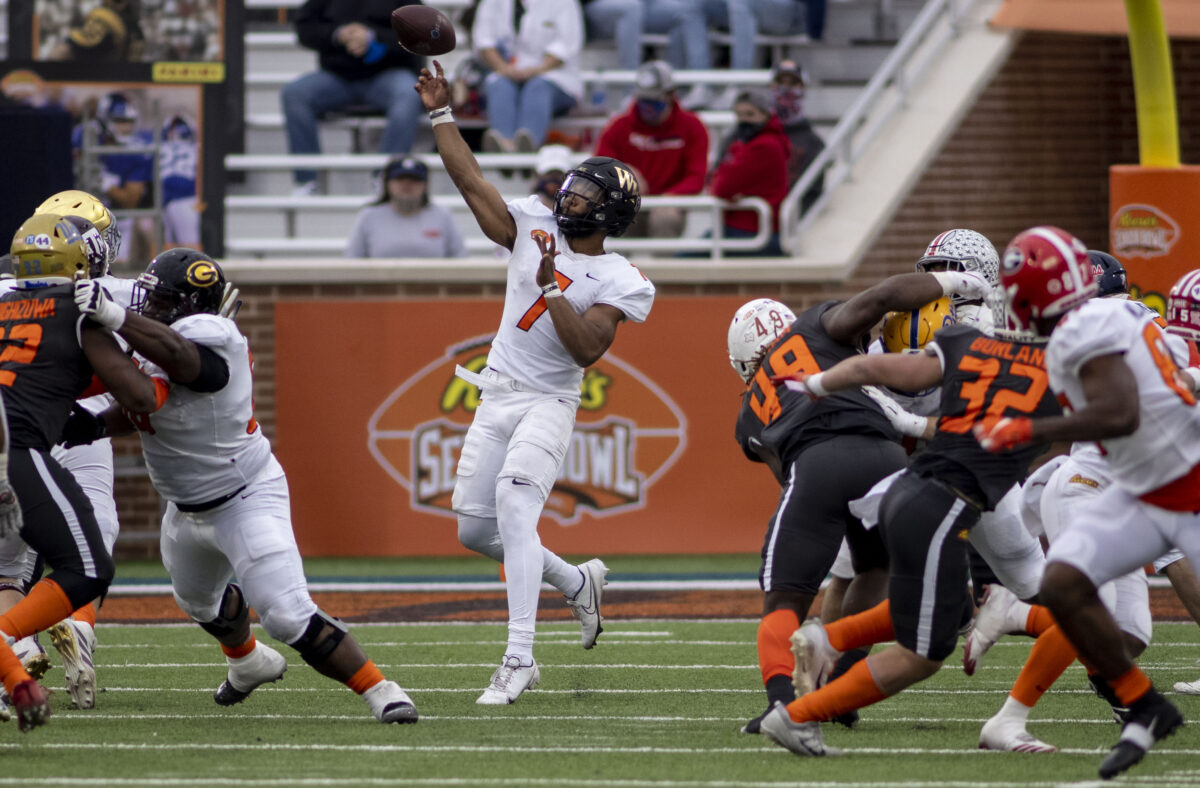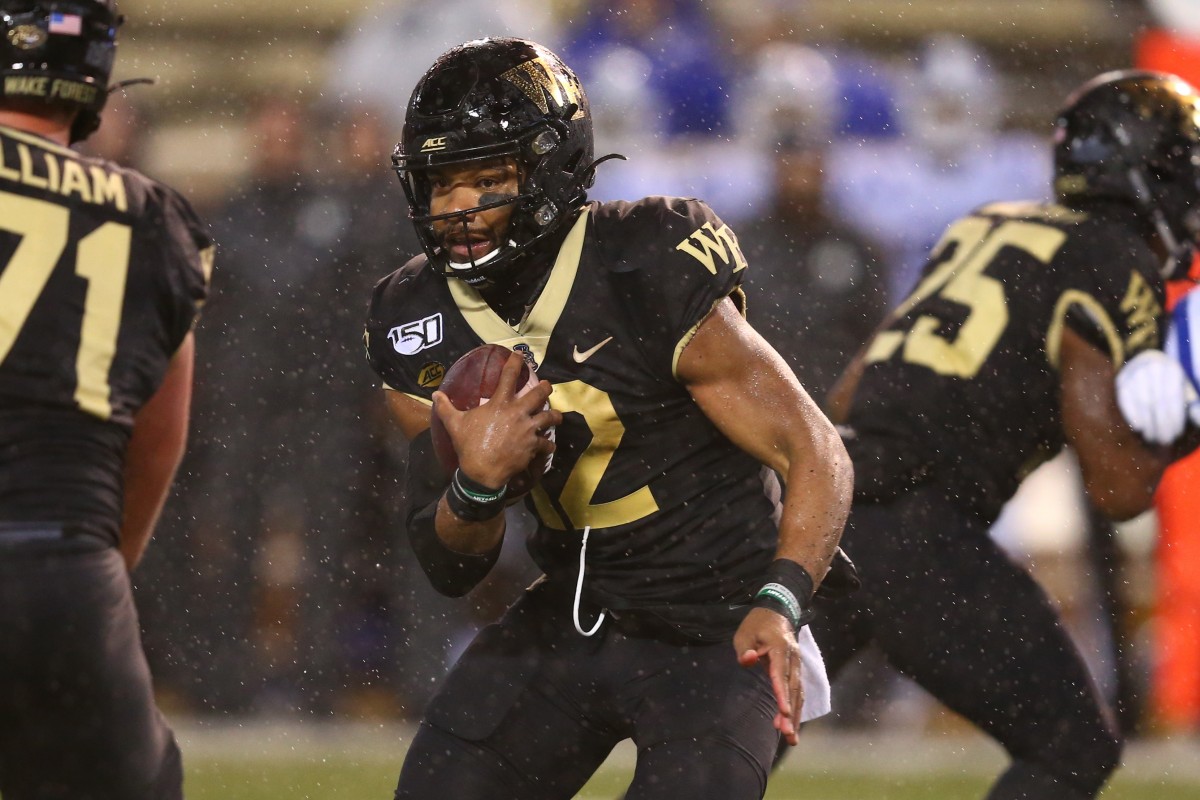The 2021 Senior Bowl offers up a chance to review the newest crop of potential NFL rookies and that’s been even more important in these COVID-19 times. Evaluating new players will be more challenging than ever with the incoming players having played fewer games, jumbled schedules or no schedules at all, or having opted out for the 2020 season. Add in the lack of an NFL Combine this year and the Senior Bowl is the only place to watch a collection of college players from various schools play together.
Of course, the bulk of the first round of the NFL draft usually involves declared juniors looking to cash in early on their talent. But in past years, the Senior Bowl allowed a glimpse of players that would go on to productive NFL careers, and therefore produce fantasy value. Few players take more than five or ten turns with the ball since they attempt to give everyone playing time.
Notable players from recent Senior Bowls:
2020
QB Justin Herbert (pass 9-12-83, TD)
QB Jalen Hurts (pass 6-13-58 TD)
RB Joshua Kelley (rush 15-105)
RB Antonio Gibson (rush 11-68)
WR Chase Claypool (receive 2-6, TD)
2019
QB Daniel Jones (pass 8-11-115, TD)
RB Tony Pollard (rush 8-60, TD)
WR Terry McLaurin (rush 1-19, receive 4-53)
WR Andy Isabella (receive 7-74, TD)
2018
QB Josh Allen (pass 9-13-158, 2 TD rush 5-19)
RB Kalen Ballage (rush 10-57)
RB Rashaad Penny (rush 9-64, receive 1-74 TD)
WR DJ Chark (receive 5-160, rush 1-9)
WR Tre’Quan Smith (receive 5-79, TD)
WR Michael Gallup (receive 3-60)
Notable 2021 performances
While 2021 is considered a rich draft for potentially elite quarterbacks, the consensus Top-5 are all underclassmen. Kyle Trask (Florida) did not play but a few of the expected Day 3 senior quarterbacks did.
QB Feleipe Franks (Arkansas, 6-6, 228) – Completed 9-of-16 for 122 yards and a touchdown but never ran the ball. Franks played three years for Florida before starting his senior year at Arkansas, where he threw for 2,107 yards and 17 touchdowns. He totaled nine rushing touchdowns in college with moderate rushing ability.
QB Kellen Mond (Texas A&M, 6-3, 217) – Completed 13 of 25 for 173 yards and two touchdowns. Ran twice for 11 yards. Mond played all four years for the Aggies and topped out at 3,107 passing yards with 24 touchdowns as a sophomore. He ended with 71 passing scores in his career. He ran for as many as 500 yards in a season and totaled 22 rushing touchdowns there.
QB Jamie Newman (Georgia, 6-3, 235) – Completed 10 of 14 for 118 yards and a touchdown. Only had the one full season as a starter for the Bulldogs when he threw for 2,868 yards and 26 touchdowns. He also added 574 yards and six scores on 180 rushes so he’s one of the dual-threat entrants in the NFL draft.
Almost all of the elite running backs coming from college are juniors since it doesn’t make much financial sense to remain in school where he could be injured and not reach for the big payday in the NFL. Even sitting on the bench in the NFL pays a lot more being on a college team (wink, wink, nudge, nudge, say no more). There is still talent that remains for that final year, but they mostly end up as depth or the lesser-halves of committee backfields. But you never know.
RB Michael Carter (North Carolina, 5-8, 199) – Ran for 60 yards and a score on his eight rushes and caught two passes for 15 yards. Carter played all four seasons for the Tar Heels but was never more than half of a committee. He led the team with 156 carries for 1,245 yards and nine touchdowns last year but teammate Javonte Williams had about the same stats but with 19 scores as the bigger back (220 lbs.) and the declared junior is expected to be a Top-5 pick. Carter projects to be another “lesser half” of a committee in the NFL. But Carter was the only running back in the Senior Bowl with more than 18 rushing yards.
Not unlike running backs, elite college receivers leave school after their junior seasons in almost all cases. So the Senior Bowl tries to give some playing time to a large number of receivers that will likely end up as No. 2 NFL receivers at best. There are always the occasional exceptions, but the problem with the Senior Bowl and receivers is volume.
There were 20 players with a reception in this year’s game. A few were stand-outs.
WR Dez Fitzpatrick (Louisville, 6-2, 210) – Easily led all other receivers in the game with six catches for 90 yards. The Cardinal played all four years in a powerful offense but never caught more than 45 passes or gained more than 833 yards in a season. Scored nine times as a senior and while his volume was only moderate at school, he was their leading receiver.
WR Shi Smith (South Carolina 5-10, 190) – Led the American Team in the Senior Bowl with three catches for 57 yards. He’s a smaller player that uses 4.4/40-time speed to his advantage. Four-year starter for the Gamecocks, he topped up with 57 catches for 633 yards and four scores there. He’ll be a Day 3 pick by a team looking to develop a slot receiver.
TE Quintin Morris (Bowling Green, 6-4, 251) – Ended with three catches for 52 yards as the second-best receiver for the American team. Does not appear on many draft boards so far, but a nice showing at the Senior Bowl will help his case. Morris started the final three years at Bowling Green and topped out with 55 catches for 649 yards and four scores as a junior.
TE Kenny Yeboah (Ole Miss, 6-4, 247) – Caught two passes for 27 yards and a 21-yard touchdown as the longest-scoring play in the game. Will be a Top-10 tight end selected this year and can play any receiver position in the NFL including the “Y”. He too light to be an every-down blocker and turned in 27 catches for 524 yards and six touchdowns as a senior last year. Averaged 19.4 yards so he’s not a standard tight end.
The lack of an NFL Combine means the Senior Bowl was the only place to see some draft prospects playing together. There will be more Pro Days that we’ll cover but the 2021 NFL draft will be even more of a crapshoot than most seasons. Given the opt-outs, missing games, COVID-19 issues, and a potential second year of limited practices in the summer mean even less will be known from this year’s crop.
And within that, even more lower-drafted or rookie free agents that make NFL teams and contribute in their first year.











 :
: 